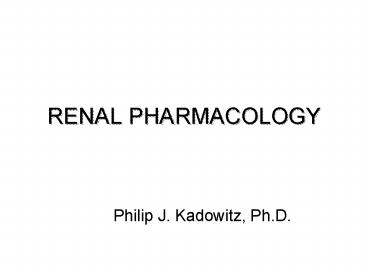RENAL PHARMACOLOGY - PowerPoint PPT Presentation
1 / 9
Title:
RENAL PHARMACOLOGY
Description:
... PGE2, PGI2, PGF2 , TXA2, thromboxane A2, bradykinin, angiotensin II, losartan, ... 3. Kinins (Bradykinin) potent vasodilator, may promote prostaglandin synthesis ... – PowerPoint PPT presentation
Number of Views:1166
Avg rating:4.0/5.0
Title: RENAL PHARMACOLOGY
1
RENAL PHARMACOLOGY
- Philip J. Kadowitz, Ph.D.
2
Learning Objectives
- Explain how GFR is regulated.
- Describe how vasoactive agents influence GFR.
- Describe the steps involved in the formation of
prostaglandins, nitric oxide and angiotensin. - Describe how the kidney regulates the release of
renin. - Discuss renal transport processes.
- Drugs prostaglandins (PG), PGE2, PGI2, PGF2?,
TXA2, thromboxane A2, bradykinin, angiotensin
II, losartan, captopril, valsartan, irbesartan,
ramipril, fosinopril, benzepril, quinapril,
COX-1, COX-2, NOS
3
Endogenous Substances in the Kidney
- A. RENAL VASODILATORS promote diuresis
- 1. Dopamine stimulates alpha, beta and
dopamine receptors and increases renal blood
flow increases glomerular filtration rate main
effect is to increase renal blood flow
increases Na excretion. - 2. Prostaglandins PGE2 and PGI2 increase renal
blood flow, promote diuresis and natriuresis.
Complications of prostaglandin inhibition with
non-steroidal anti- inflammatory drugs acute
renal failure, hyperkalemia. - 3. Kinins (Bradykinin) potent vasodilator, may
promote prostaglandin synthesis and nitric oxide
release. Increases cGMP and cAMP formation.
4
B. Renal Vasoconstrictors
- 1. Thromboxane A2 Formed in the kidney
during pathophysiologic conditions (e.g.,
obstruction of a ureter). PGE2 and PGI2 are
released to counteract the vasoconstriction. - 2. Norepinephrine
- 3. Angiotensin II - potent vasoconstrictor.
5
Figure 312. A. A Schematic Portrayal of the
Three Major Physiological Pathways Regulating
Renin Release.
6
Figure 151. Tubule transport systems and sites
of action of diuretics
7
(No Transcript)
8
(No Transcript)
9
III. RENAL TRANSPORT PROCESSES The
important homeostatic role of the kidney is in
maintaining the volume and composition of the
body fluids. This is done by filtration through
the glomerulus, reabsorption by the renal tubles,
and secretion into the tubular
urine. A. Glomerular
filtration - occurs if substance is water
soluble, molecule in lt70,000 MW, and adequate
hydrostatic pressure of the blood (sufficient
blood pressure). Common causes of reduction in
GFR are organic disease, congestive heart
failure, antihypertensives. B.
Tubular transport - 1. Active
transport - takes place in proximal tubule a.
Anionic transport system - weakly acidic
substances secreted by the same mechanism as
uric acid. Uricosuric drugs (probenecid,
sulfinpyrizone and salicylates) compete with uric
acid and presents reabsorption of uric acid from
the tubule. b. Cationic transport system -
weak basic substances are secreted by the same
transport system that secretes creatinine.
Trimethiprim (an antibiotic) and cimetidine (used
in the treatment of ulcers) both compete with
creatinine for their secretion. The creatinine
may be elevated, suggesting decreased renal
function, but GFR is unchanged. 2. Pass
ive transport - occurs in distal tubule. Passive
reabsorption, flow dependent and pH dependent.






























